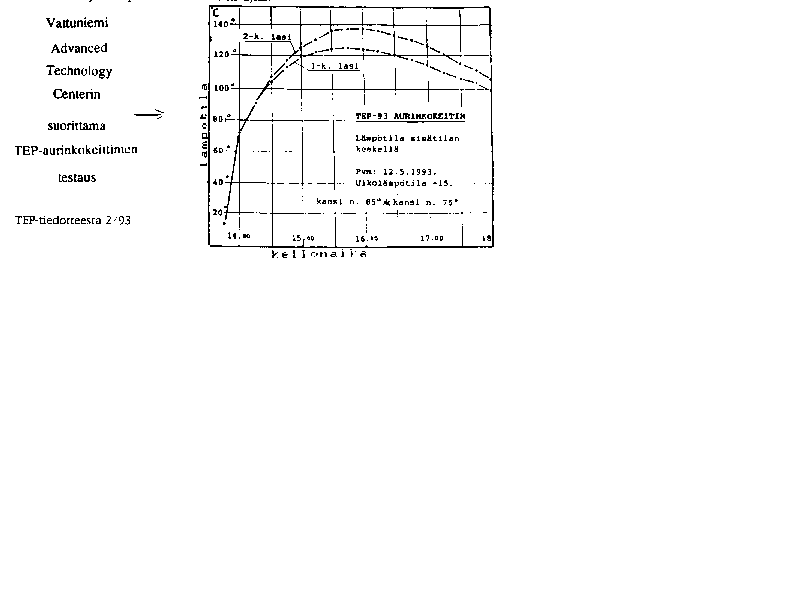
The solar cooker is a simple solution to a complex problem. Burning wood in poor, over-populated regions only serves to boost desertification. At the same time, the greenhouse effect speeds up when the carbon liberated from the wood turns into carbon dioxide in the athmosphere. On the other hand, wood has to be burned if you want cooked food or even clean water. When everyone else has the same needs, foraging of firewood takes longer and places an overwhelming burden particularly on the women in the developing countries.
Apart from the fact that the solar cooker is a good solution for global environmental problems. it brings immediate relief to women exhausted from physical work. Into the bargain. it does not pollute, it is clean and simple. It can be built anywhere and the necessary materials are available everywhere.
The cooker is not a commercial product, or at least that was not the objective. "We tried to produce a cooker that everyone could make, so there is no market for such products", inventor Risto Kekkonen says.
But perhaps the appliance could be sold in the rich West as a real ecological and health product: it is the healthiest way to cook food - in a temperature of 120-140 degrees Celsius. It also works in northern climates.
"I have cooked eggs in it even when the temperature has been a little below zero", explains Kekkonen.
It takes time, but you do not need to watch it and it is vety suitable for use in summer cottages.
Outwardly. the solar cooker is simple, just like a double-lined suitcase. The outer cover is intended to direct sun's rays into the cooking receptacle and for this reason its angle of inclination can bc adjusted. The purpose of the inner cover is to keep the reflected heat inside. Therefore. the cover can be any translucent material able to withstand heat. such as glass.
The cooker is lined with reflective aluminum foil, apart from the bottom which is covered with a black dish. Old newspapers or even grass can be used as heat insulation. The robust frame is made of waste-cardboard. The only demanding technical feature is the hinging of the twin-cover.
The price for the device is about FIM 100- 150 when made in Finland. The more expensive parts are the glass, aluminum foil, black base dish and the metal hinges.
The cooker can accommodate two five-liter cooking dishes which must be black. Cast iron is excellent.
At its best, the appliance has a power of 125 watts. It weighs about seven kilos and takes about ten hours to construct once you know how.
From the users viewpoint, the most important fact is that in Namibia, it is sufficient for the needs of a family of ten. And the food cooks, slowly but surely. If it rains while you are cooking, the device has to be closed, but the food keeps warm under the cover for hours.
Rice takes one hour to cook, chicken, fish and potatoes take two hours, maize and bread take three hours and a joint of roast meat from 4-5 hours.
Finns living at the Namibian village of Oshakati prepared traditional Christmas dishes in 4-5 hours including sweetened potato casserole which is perhaps one of the Finnish dishes that needs the highest temperature. All the other dishes were kept warm during the festive periood in the cooker.
According to Risto Kekkonen, solar cookers have been made before, but he was unwilling to talk about the competitors. "We are aiming at the same thing", says Kekkonen, who regards his own invention as more solid and durable. The cooker was deveped by the Finnish organization Technology Professionals for Life and support was received from several organizations, such as Church Foreign Aid and Finnida which coordinates Finnish development aid.
Moreover, the technology of the cooker has received recognition from experts in the field and it obtained an honourable mention and a FIM 15,000 prize in the Environment Award competition arranged by the Society of Engineers in 1992.
In principle, the solar cooker could ease the firewood problems of up to 1.5 billion people. The idea is that they would be made in vocational schools or village workshops in the Third World.
The cooker has also been criticized. It is claimed that it would destroy the African tradition of sitting around a camp fire.
Kekkonen admits that this may be the case. On the other hand, who knows whether the bonfire is a tradition as much as a necessity.
"Because of the need to collect firewood, it was impossible to start cooking much before the evening anyway. At least now. with the solar cooker, even the women can enjoy the camp fire, because the food has already been prepared and cooked during the day. It just means that somebody else would have to collect the firewood, quips Kekkonen.
